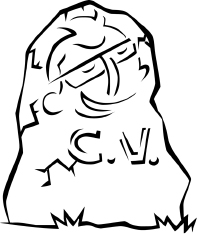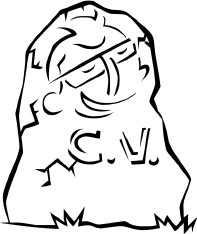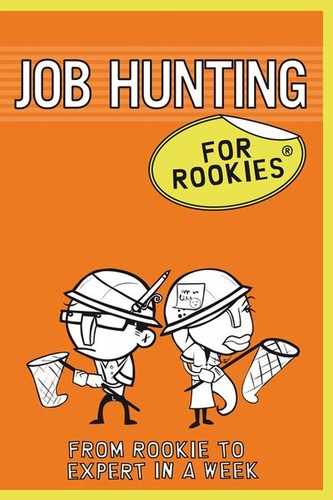CHAPTER 3
Constructing a solid CV
Tailoring individual CVs
Most job adverts receive many dozens – if not hundreds – of applications. In order to decide whom to invite to interview, the employer may spend as little as a minute glancing through each CV.
So savvy job seekers do everything in their power to help the employer to see immediately how they stack up to the requirements of the job. And they do this by tailoring each and every CV they send out.
Gone are the days of creating a single CV and sending it to every organization you might want to work for. Sure, that used to be standard practice maybe 10 or 15 years ago. But the job market is much more competitive now. And to keep up, you need to tailor every single CV you send out. Even if you are sending out CVs for the same type of job to companies that you think are very similar, you will get the best results by tailoring each CV. If you don’t, you will almost certainly end up on the employer’s discard pile.
 Rookie Buster
Rookie Buster
Gone are the days of creating a single CV and sending it to every organization you might want to work for.
Why tailor?
Let’s work through an example and you’ll see why tailoring your CV is so very important. Suppose you are applying for a job as an office administrator and are faced with the two following job adverts:
ABC Banking Corporation Business administrator needed to track loan applications from inception through to rejection or acceptance; produce monthly status reports for senior management; and file additional documentation and maintain database. Qualities required: • Excellent administrative skills • Creativity and willingness to use initiative • Ability to multi-task • Excellent written and verbal communication skills • Exceptional organization skills |
XYZ Home Trading Administrative officer needed to join head office team of this growing retailer. Role involves using spreadsheets and databases to keep track of inventory movements from suppliers through warehousing and to stores. The successful candidate must have strong administration skills and communication skills with both junior and senior people. Experience within a customer-facing environment is required. Excellent attention to detail and ability to work to tight deadlines desirable. |
Most job hunters include a section on their CVs using the heading of “Key Skills”. So what key skills would you highlight in applying for these two jobs?
As you can see, ABC Banking Corporation asks for someone with “excellent administrative skills” while XYZ Home Trading is looking for someone with “strong administration skills”. Those two phrases are very similar so you could use either phrase interchangeably on both the CV you send to ABC as well as XYZ.
ABC then lists “creativity and willingness to use initiative”, “ability to multi-task”, “excellent written and verbal communication skills”, and “exceptional organization skills”. The job at XYZ may in fact be very similar to the job at ABC, but >XYZ has emphasized that it is looking for “communication skills with both junior and senior people”, “experience within a customer-facing environment”, “excellent attention to detail” and “ability to work to tight deadlines.”

So while it would be a good idea to list “creativity and willingness to use initiative” in the CV you send to ABC, you would gain no points for listing it in the CV you send to XYZ. And while XYZ clearly wants to hire someone with “experience within a customer-facing environment”, why should ABC be at all interested if you mention that fact on your CV to them?
Make a clear connection
Now, you may think that both employers should be able to read between the lines, make the connection and tell that you are a good administrator. But remember that the employer is inundated with many, many CVs! The employer is probably tired of reading through CVs. The employer’s attention may wander. So you need to make the link between your skills and what the organization is looking for. You need to make the link blindingly obvious.
If an employer is looking for certain skills or qualities, you use their precise wording on your CV. If they say “leadership skills”, you say “leadership skills”, not “management skills”. If they say “managing risk”, you don’t say “avoiding risk” or “being cautious”, you say “managing risk”. Nothing beats repeating back to employers the precise, exact profile of the person they are looking for.
 Rookie Buster
Rookie Buster
If an employer is looking for certain skills or qualities, you use their precise wording on your CV.
Matching what you have with what the employer wants
Skills and knowledge
To begin tailoring your CV, take a sheet of paper and draw a line down the middle, from top to bottom. Now take a look at the job advert and list on the left-hand side of the page all of the skills and knowledge the employer is looking for.
Once you’ve done that, list on the right-hand side of the page all of the skills and knowledge that you have that could be relevant. Bear in mind that some of the skills and knowledge you possess may have been gained in either paid employment or unpaid work such as volunteering, your studies, or bringing up a family.
Qualifications and training
Get a clean sheet of paper and again draw a line down the middle from top to bottom. Write down the different qualifications and training that the employer needs on the left side of the sheet. And write the relevant qualifications and training that you possess on the right.
Outcomes and achievements
Finally, take a look back at Chapter 2 to list the outcomes that you think this particular employer wants to achieve. List those outcomes on the left side of a sheet of paper. On the right side of the sheet, write down the achievements you have accomplished that demonstrate your ability to deliver those outcomes.
Again, in filling out the right-hand column, consider that your achievements may have been accomplished in either your paid or unpaid work, as well as your professional or personal life.
Investing to succeed
You may be reading this and thinking, Yes, it would be nice to do some research and tailor every CV I send out – but I don’t have the time. Be careful. You’re at risk of falling into a very, very big trap. Granted, sending out the same CV to more than one employer will save you time. But it’s a false economy. Because you’re almost certain not to get invited to an interview.
When most job adverts receive so many applications, you can be guaranteed that someone else will have spent time carefully researching the organization and tailoring their CV to make them seem like the perfect candidate. Against that kind of competition, a standard CV just doesn’t stand much of a chance.
Taking an hour to send out one tailored, carefully targeted CV is a better use of your time than sending out a dozen more-or-less identical CVs. You have been warned!
 Rookie Buster
Rookie Buster
Taking an hour to send out one tailored, carefully targeted CV is a better use of your time than sending out a dozen more-or-less identical CVs.
Creating your profile statement
Your name goes at the top of your CV. Then the next bit of your CV to write is a profile statement. Sometimes also called a “career objective” or an “asset statement”, a profile statement is a short (one to five sentence long) paragraph at the top of your CV announcing who you are and how your strengths and achievements can help an employer. Here are a handful of examples:
A help desk operative with a confident telephone manner and outstanding knowledge of PC systems and remote working. I am customer-focused and have a reputation of exceeding callers’ expectations when they need talking through on computer-related issues.
Human resources professional with responsibility for looking after an internal customer base of 500 employees. Experienced in projects relating to: recruitment and selection, leadership development, staff development, compensation and benefits. Managed one human resources assistant. Interacted frequently with senior managers to deliver successful human resources initiatives.
I graduated with an upper second class degree in history and economics. I have experience of working in several office environments. In order to pursue a career in marketing, I recently spent two weeks on an internship at Molloy & Channing.
Your profile statement plays an important role, enabling employers to figure out immediately why they should pay attention to the rest of your CV. But bear in mind that employers are not interested in what you want. You must summarize what you can offer an employer. So never tell them what kind of work you are looking for. Always tell them about your experience, skills, knowledge or the outcomes you have delivered that will help your target employer to succeed in its goals.
 Rookie Buster
Rookie Buster
Your profile statement plays an important role, enabling employers to figure out immediately why they should pay attention to the rest of your CV.
Deciding on the right format for you
The first decision you make – before you write a single word of your CV – is the format that will best showcase your talents and experience.
The traditional way to lay out your CV is to list your employment and education details in a reverse chronological format. In other words, you list your most recent employment, followed by your previous job, the one before that, and so on. Then you do the same for your education, listing your most recent qualifications or schooling and then going backwards in time.
However, the reverse chronological format does not suit everyone. So instead many people choose to adopt a skills-based (also called a “functional”) format for their CV instead. Let’s look at examples, and the pros and cons of each.
Reverse chronological format
On the next page you’ll see the basic layout of a reverse chronological CV.
[YOUR NAME]
Address, city, postcode
Telephone numbers; email address
EXPERIENCE
20** – present Job title, Employer’s name, Employer’s location A brief paragraph (two to a maximum of five sentences) on your role in the organization, including details of your key responsibilities.
• Your most impressive achievement in this role (that is relevant to this particular employer).
• Your second most impressive and relevant achievement.
• Your third most impressive achievement.
20**–20** Job title, Employer’s name, Employer’s location (Repeat as for your current job)
19**–20** Job title, Employer’s name, Employer’s location (Repeat as for your current job)
Etc.
EDUCATION AND TRAINING
List here in reverse date order (in other words, most recent ones first) your most impressive qualifications, training courses attended, professional memberships, degrees and so on.
In listing your achievements, remember to lead with the most impressive and relevant information for that particular employer. I can’t stress this point enough. What impresses one employer may not impress the next. And consider the advantages and disadvantages of the reverse chronological format:
Pros

• The most popular way to set out your experience and education.
• The format confirms the continuity of your experience, such as that you have had 8, 10 or 20 years’ unbroken experience in a field or profession.
Cons
• The reverse chronological format does not suit people who are trying to change from one field of work to another (for example, from one occupation to another, from military service into commercial work, from one sector into another, etc.).
• This format can expose periods of unemployment.
• This format can expose the fact that you don’t have very much work experience.
• This format can expose the fact that you didn’t stay long in your previous roles.
Skills-based format
The skills-based format focuses the reader’s attention on how you meet the requirements for the role (rather than on your actual employment history). On the next page you’ll see the basic layout of a skills-based
[YOUR NAME]
Address, city, postcode
Telephone numbers; email address
SKILLS/ACHIEVEMENTS
Your top skill (in other words, the one that is most relevant and impressive to this particular employer).
• Your most impressive achievement, illustrating how you used this skill to deliver a positive outcome for an organization.
• Your next most impressive achievement.
Your second top skill.
• (Repeat as per your top skill.)
Your third top skill.
• (Repeat as per your top skill.)
Your fourth top skill (if necessary).
• (Repeat as per your top skill.)
EXPERIENCE
20**–Present 20**–20** 20**–20** Etc. |
Job title, Employer’s name and location Job title, Employer’s name and location Job title, Employer’s name and location |
EDUCATION AND TRAINING
Summarize very briefly your qualifications, degrees or other education.
Again, you may need to choose to highlight different skills to impress different employers. And here are the pros and cons of using a skill-based format:
Pros
• You can direct the reader’s attention to how you are right for the job rather than the fact that you may not have the traditional background and employment history that he or she is expecting.
• You repeat back to the employer exactly the key skills (based on your reading of the job advert and research) that the organization is looking for.
• You can downplay work experience that is not entirely relevant to the kind of work you are now looking for.
Cons
• Experienced employers can sometimes be suspicious of CVs that do not list your employment history first. As such, the reader may assume that you are hiding something such as inappropriate work experience or educational failings.
• A skills-based format may not make the most of your employment history if you have worked for companies that are household names within your industry.
 Rookie Buster
Rookie Buster
In listing your achievements, remember to lead with the most impressive and relevant information for that particular employer.
Making the right choice of format
The reverse chronological format may hamper you if you are looking to do something that is different from what you have done in the past. Say you are a receptionist, but now want to become a teacher. Or a bank manager, but want to retrain as a veterinary nurse. Listing your relevant skills in a skills-based format may be the better choice for you.
The skills-based format may also be better for you if you are a recent graduate or school leaver with little or no work experience. You can talk about how you have demonstrated the right skills in your studies and unpaid experiences.
And the skills-based format can help candidates with significant gaps in their career history (for instance due to unemployment or illness) or “job hoppers” who may be perceived by employers as lacking commitment.
So which format is going to suit you best?
Capturing your contact details
OK, let’s get started on the next section of your CV. Always begin with your name at the top (you don’t need to say “Curriculum Vitae” or “CV”, as it is obvious enough what the document is) and personal profile. Then most CVs include certain contact details. And here’s how they should be set out:
TERESA HOLLINS
Marketing manager with 10 years’ experience of working with branded consumer goods. I lead and coach a team of five people. Having originally trained as an accountant, I have a firm grasp of numbers and am focused on helping the business to create value for shareholders.
[Your profile statement should take up the first 3 to 5 sentences here.]
Address: Flat 7, 5th Floor, 11 Carrington Road, Birmingham B99
8ZP
Phone: 0191 7891 5476
Mobile: 07911 3021 6481
Email: [email protected]
Now, that looks simple enough, right? A couple of pointers, though:
• Make sure that if you give your home telephone number, you have an answering machine or answering service to record calls if you cannot answer the telephone yourself. And consider getting a separate, cheap, pay-as-you-call mobile phone if you don’t have one already, so that you will know that any calls you receive on that phone are of the utmost importance.
• Include a personal email address rather than the one you currently use for your work. Employers are legally permitted to check that your work email is being used only for work purposes – you could find yourself fired if your employer finds you using your work email address to look for a new job!
• And use a sensible email address. Avoid “[email protected]” or “[email protected]”, as some employers might object to such supposedly humorous email addresses.
• Do not include your marital status or the number of children you have. I have never met a single employer who has ever thought “Oh, this person is married and has two children – I must give her the job!”

Avoiding the seven deadly sins of writing your CV
There are many myths about what constitutes a winning CV. Be sure to avoid the following fatal flaws when pulling together your CV.
Sin 1: Being too verbose
Keep your CV short! Your CV should whet the reader’s appetite to find out more about you; you should not be aiming to inundate the employer with absolutely everything that can be said about you.
As a rule of thumb, keep your CV to one page if you have five or fewer years’ paid work experience. If you are more experienced, feel free to have two pages. Only if you have substantial (i.e. 10+ years), directly relevant experience should you stretch to three pages. Anything more than three pages merely tells the employer that you are a long-winded person who struggles to be concise.
Sin 2: Making pompous claims about yourself
It’s fine to talk about skills such as influencing people or analysing problems. And it’s good to mention achievements such as the actual results you have attained. But steer clear of describing yourself using phrases such as “an ambitious worker with an optimistic, supportive and helpful attitude” or “a talented, warm individual with management potential”.
Be very careful of using empty adjectives. Strong candidates avoid adjectives entirely and instead give brief examples to prove that they have the right skills.
Sin 3: Delving into the distant past
Focus the reader on your recent employment history. An employer is most interested in what you have been doing in the last five to ten years. If you have more than ten years’ experience, summarize your early days rather than giving them too much space on your CV. Perhaps include a heading on “Experience” for your most recent few years, and then another heading below that entitled “Experience prior to 1999” (or whatever year you choose) and condense anything that is less recent.
This point is especially important if you feel that you may have too much experience (for example, if you are sure that most of the other applicants for the job may be considerably younger). Try this tactic also if you have the wrong sort of experience (for instance if you spent the first few years of your career doing the “wrong” job before you changed into the “right” one for you) for a job and need to gloss over some of your earlier work details.
 Rookie Buster
Rookie Buster
An employer is most interested in what you have been doing in the last five to ten years.
Sin 4: Including irrelevant information
You will notice that I have not included a section on either the reverse chronological or skills-based CV formats for sections such as “extracurricular activities” or “hobbies and interests”. And that’s because, for most people, including such a section adds nothing to a CV.
I realize that many job hunters want to add information to their CVs to show that they have lives outside their work. But employers don’t care. The truth is that employers are more interested in how you can use your skills and experience to help them succeed than they are in your life outside work. So include extracurricular activities only if they are relevant and impactful and recent.
For instance, if you are applying for a job in marketing, then mentioning that you “attend regular conferences and seminars of the National Institute of Marketing and Communications” may strengthen your application. But mentioning that you “play the guitar in spare time”, “read books and go to the cinema” or “spend time with my family” isn’t going to impress an employer.
Similarly, do mention if you play a team sport (as employers sometimes believe that people who play team sports are better team players at work). But don’t mention it if the last time you played a team sport was more than five years ago – because that just makes it sound as if you haven’t done anything worthwhile in the last five years!
 Rookie Buster
Rookie Buster
Include extracurricular activities only if they are relevant and impactful and recent.
Sin 5: Providing too much information
Never share the reasons you left your past jobs unless you are specifically asked to do so. You may need to answer questions about why you left your current or previous jobs during a job interview, but you do not need to mention your reasons, even in passing, on a CV.
Whether you’re currently employed, have just been made redundant, or have been out of work for some time, you should not include such information. The vast majority of job hunters do not share such information on their CVs. So choosing to include such information on your CV can therefore raise suspicions about your loyalty in the mind of an employer. Focus instead on the skills, achievements and experience that you can offer to help the potential employer with its goals.
In fact, strip out all shortcomings, negative information or tales of adversity on your CV. So if you have been ill or have suffered family difficulties, or anything else – do not mention it on your CV. Remember that a CV is a sales document – it is designed to promote your best skills and attributes.
And avoid mentioning your current salary or salary requirements unless the employer specifically asks for it too. The danger of mentioning it on your CV is that if you are too expensive, you will immediately be eliminated from consideration. By not mentioning it, you may be able to meet the interviewers and impress them so much in person that they could raise the maximum salary they are willing to pay.
Sin 6: Going crazy with the design of your CV
Your CV must be a professional-looking document. So bear in mind the following pointers:
• Use sheets of standard-sized plain white paper for printing out your CV. Coloured paper, especially thick paper, or paper of an unusual shape or size only annoys the person trying to file it.
• Choose a simple typeface such as Helvetica or Times Roman. And use the standard font size that your word processing program uses as its default. Avoid shrinking the font size to squeeze more on to your CV – experienced employers immediately spot this as the tactic of a desperate job hunter who can’t prioritize what to include on a CV.
• Use the standard settings for the margins, headers and footers of your CV too. Avoid reducing them to squash more content on to your CV. Choosing carefully what to include on your CV to sell your talents will make a better impression than trying to cram as much as you can on to the printed page.
• Be careful of trying to impress an employer through gimmicks. Very few employers appreciate gimmicks, such as jokes printed on CVs, and most experienced employers have seen them all before.

Sin 7: Making spelling or grammatical mistakes
There really is no excuse for having either spelling or grammatical errors on your CV. Any errors on your CV immediately raise questions in the mind of the reader about your attention to detail (or your lack of it).
One of the problems is that you get so used to looking at your own CV that your brain stops looking for mistakes. To make sure you sidestep this sin, work your way through these three steps:
1. Use the spell checker on your computer to check for common spelling mistakes.
2. Print out your CV and read through it line by line. By the time you have worked on your CV a few times, your eyes may get used to ignoring mistakes on a computer screen. Print it out and read through it line by line, covering up the rest of the CV with a ruler or sheet of paper. S-l-o-w down and you may spot errors that you overlooked on screen.
3. Print out your CV and give it to a friend or two to read. Explain to your friends that you would appreciate it if they could point out any errors or even sentences that do not make immediate sense.

Coach’s notes 
• Tailor your CV. Yes, it does take longer to write a CV that perfectly meets the needs of a particular vacancy. But given that there will be other job hunters who are tailoring their CVs, any CV of yours that does not perfectly meet the brief will almost certainly end up in the discard pile.
• Write a profile statement by carefully choosing 1 to 5 sentences to explain how your skills and achievements can help a potential employer to meet its goals. But remember that the profile statement you use for one job may differ subtly from the one you use for another job.
• Consider the pros and cons of a reverse chronological versus a skills-based format for your CV. The reverse chronological format demonstrates your continuity of experience. The skills-based format demonstrates your skills and achievements even if you may not have exactly the background and career history that the employer is expecting to see.
• Keep the rest of your CV simple. When considering whether to include a particular piece of information about anything – your education, your marital status, your hobbies and interests, and so on – always make sure that it is relevant and impactful and recent.
Go for it! Always, always, always write your CV with employers in mind. Remember that you should include the kind of information that employers want to hear – not the stuff that you want to mention! And think about the order of information so that your most impressive stuff hits the reader straight away. Do that, and you give yourself the best shot at getting invited along to an interview.

Notes |

